Saltwater Intrusion in the Changjiang River Estuary in Response to the East Route of the South-to-North Water Transfer Project in the New Period after 2003
Abstract
1. Introduction
2. Materials and Methods
2.1. Methodology and Data
2.2. Numerical Model
2.2.1. Model Setting
2.2.2. Model Verification
2.3. Case Study Setting
2.3.1. Tidal Dynamic Conditions
2.3.2. Runoff Conditions
2.3.3. Water Abstraction Discharge Conditions in the East Route of the South-to-North Water Transfer Project
2.3.4. Case Study Setting
3. Results and Discussion
3.1. Influence of the East Route of the South-to-North Water Transfer Project on Estuarine Saltwater Intrusion
3.2. Intrusion Distance of 0.45‰ Iso-Salinity Front
3.3. Estimation of Freshwater Resources in the Estuary
3.4. Unsuitable Water Intake Times for Reservoirs in the Estuary
3.5. Ecological Discharge of Estuarine Saltwater Intrusion in Dry Season
4. Conclusions
Author Contributions
Funding
Institutional Review Board Statement
Informed Consent Statement
Data Availability Statement
Acknowledgments
Conflicts of Interest
References
- Chen, Q.; Zhu, J.R.; Lyu, H.H.; Pan, S.Q.; Chen, S.L. Impacts of topography change on saltwater intrusion over the past decade in the Changjiang Estuary. Estuar. Coast. Shelf Sci. 2019, 231, 106469. [Google Scholar] [CrossRef]
- Wu, H.; Zhu, J.R.; Choi, B.H. Links between saltwater intrusion and subtidal circulation in the Changjiang Estuary: A model-guided study. Cont. Shelf Res. 2010, 30, 1891–1905. [Google Scholar] [CrossRef]
- Lyu, H.H.; Zhu, J.R. Impact of the bottom drag coefficient on saltwater intrusion in the extremely shallow estuary. J. Hydrol. 2018, 557, 838–850. [Google Scholar] [CrossRef]
- Wu, S.H.; Cheng, H.Q.; Xu, Y.J.; Li, J.F.; Zheng, S.W. Decadal changes in bathymetry of the Yangtze River Estuary: Human impacts and potential saltwater intrusion. Estuar. Coast. Shelf Sci. 2016, 182, 158–169. [Google Scholar] [CrossRef]
- Wan, Y.Y.; Gu, F.F.; Wu, H.L.; Roelvink, D. Hydrodynamic evolutions at the Changjiang River Estuary from 1998 to 2009. Appl. Ocean Res. 2014, 47, 291–302. [Google Scholar] [CrossRef]
- Qiu, C.; Zhu, J.R.; Gu, Y.L. Impact of seasonal tide variation on saltwater intrusion in the Changjiang River estuary. Chin. J. Oceanol. Limnol. 2012, 30, 342–351. [Google Scholar] [CrossRef]
- Li, L.; Zhu, J.R.; Wu, H.; Guo, Z.G. Lateral Saltwater Intrusion in the North Channel of the Changjiang Estuary. Estuaries Coasts 2014, 37, 36–55. [Google Scholar] [CrossRef]
- Shi, J.Z.; Lu, L.F. A short note on the dispersion, mixing, stratification and circulation within the plume of the partially-mixed Changjiang River estuary, China. J. Hydro-Environ. Res. 2011, 5, 111–126. [Google Scholar] [CrossRef]
- Wang, J.; Kuang, C.P.; Chen, K.; Fan, D.D.; Qin, R.F.; Han, X.J. Wave-current interaction by Typhoon Fongwong on saline water intrusion and vertical stratification in the Yangtze River Estuary. Estuar. Coast. Shelf Sci. 2022, 279, 108138. [Google Scholar] [CrossRef]
- Li, M.; Chen, Z.; Finlayson, B.; Wei, T.; Chen, J.; Wu, X.; Xu, H.; Webber, M.; Barnett, J.; Wang, M. Water diversion and sea-level rise: Potential threats to freshwater supplies in the Changjiang River estuary. Estuar. Coast. Shelf Sci. 2015, 156, 52–60. [Google Scholar] [CrossRef]
- Wu, D.; Shao, Y.C.; Pan, J.X. Study on Activities and Concentration of Saline Groupin the South Branch in Yangtze River Estuary. Procedia Eng. 2015, 116, 1085–1094. [Google Scholar]
- Xu, Z.; Dai, H.C.; Gao, X.C.; Liu, Z.W.; Yan, L.; Dong, Y.Y.; Chen, D.X. Response of saltwater intrusion in the Yangtze River estuary to runoff variability and sea level change. Adv. Water Resour. Hydropower Sci. Technol. 2023, 43, 15–21. [Google Scholar]
- Qiu, C.; Zhu, J.R. Influence of seasonal runoff regulation by the Three Gorges Reservoir on saltwater intrusion in the Changjiang River Estuary. Cont. Shelf Res. 2013, 71, 16–26. [Google Scholar] [CrossRef]
- Shao, Y.C.; Wu, D.; Pan, J.X. Study on Impact of Runoff on Saltwater Intruding from the North Branch in the Changjiang Estuary. Procedia Eng. 2015, 116, 824–833. [Google Scholar]
- Xu, K.; Zhu, J.R.; Gu, Y.L. Impact of the eastern water diversion from the south to the north project on the saltwater intrusion in the Changjiang Estuary in China. Acta Oceanol. Sin. 2012, 31, 47–58. [Google Scholar] [CrossRef]
- Wang, Y.H.; Ridd, P.V.; Wu, H.L.; Wu, J.X.; Shen, H.T. Long-term morphodynamic evolution and the equilibrium mechanism of a flood tide channel in the Changjiang River Estuary (China). Geomorphology 2008, 99, 130–138. [Google Scholar] [CrossRef]
- Ge, J.Z.; Lu, J.Y.; Zhang, J.S.; Chen, C.S.; Liu, A.Q.; Ding, P.X. Saltwater Intrusion-Induced Flow Reversal in the Changjiang Estuary. J. Geophys. Res.-Ocean. 2022, 127, e2021JC018270. [Google Scholar] [CrossRef]
- Lu, L. Characteristics and Mechanism of Spatial and Temporal Changes of Saline Water Intrusion in the Yangtze River Estuary. Ph.D. Thesis, East China Normal University, Shanghai, China, 2012. [Google Scholar]
- Werner, A.D.; Bakker, M.; Post, V.E.A.; Vandenbohede, A.; Lu, C.; Ataie-Ashtiani, B.; Simmons, C.T.; Barry, D.A. Seawater intrusion processes, investigation and management: Recent advances and future challenges. Adv. Water Resour. 2013, 51, 3–26. [Google Scholar] [CrossRef]
- Ma, J.; Zhou, Z.; Guo, Q.; Zhu, S.; Dai, Y.; Shen, Q. Spatial Characterization of Seawater Intrusion in a Coastal Aquifer of Northeast Liaodong Bay, China. Sustainability 2019, 11, 7013. [Google Scholar] [CrossRef]
- Ferreira, A.; Chachadi, A. Assessing aquifer vulnerability to sea-water intrusion using GALDIT method: Part 2—GALDIT Indicators Description. In Proceedings of the 4th Inter Celtic Colloquium on Hydrology and Management of Water Resources, Guimarães, Portugal, 11–14 July 2005. [Google Scholar]
- Zhu, J.R.; Cheng, X.Y.; Li, L.J.; Wu, H.; Gu, J.H.; Lyu, H.H. Dynamic mechanism of an extremely severe saltwater intrusion in the Changjiang estuary in February 2014. Hydrol. Hydrol. Earth Syst. Sci. 2020, 24, 5043–5056. [Google Scholar] [CrossRef]
- Li, L.; Zhu, J.R.; Wu, H. Impacts of wind stress on saltwater intrusion in the Changjiang River Estuary. Sci. China Earth Sci. 2012, 55, 1178–1192. [Google Scholar] [CrossRef]
- Matsumoto, K.; Takanezawa, T.; Ooe, M. Ocean tide models developed by assimilating TOPEX/POSEIDON altimeter data into hydrodynamical model: A global model and a regional model around Japan. J. Oceanogr. 2000, 56, 567–581. [Google Scholar] [CrossRef]
- Chen, W.; Kuang, C.P.; Gu, J.; He, L.L. Response characteristics of salt water intrusion in Yangtze Estuary to sea level rise. J. Water Resour. Water Transp. Eng. 2018, 58–65. [Google Scholar] [CrossRef]
- Lin, R.L.; Zhuo, W.S.; Zeng, K.; Liang, L.F.; Liu, R.; Liu, Z.F. Effect of different wind direction on salt water intrusion in Dongsikoumen of the Pearl River. Water Resour. Prot. 2019, 36, 66–75. [Google Scholar]
- Yang, T.J.; Wang, Y.G.; Huang, H.M.; Yuan, C.G. Numerical simulation of salt water intrusion in the Yangtze River Estuary. J. Hydroports 2013, 34, 473–481. [Google Scholar]
- Allen, J.I.; Somerfield, P.J.; Gilbert, F.J. Quantifying uncertainty in high-resolution coupled hydrodynamic-ecosystem models. J. Mar. Syst. 2007, 64, 3–14. [Google Scholar] [CrossRef]
- Wang, Y.G.; Huang, H.M.; Li, X. Critical discharge at Datong for controlling operation of South to North Water Transfer Project in dry seasons. Water Sci. Eng. 2008, 1, 47–58. [Google Scholar]
- GB 5749-2022; Standards for Drinking Water Quality. China Quality and Standards Publishing & Media Co., Ltd.: Beijing, China, 2022. (In Chinese)
- Huang, H.M. Research of salt Intrusion in Estuary of Yangtze River through 1D and 2D Numerical Model. Master’s Thesis, Hohai University, Nanjing, China, 2006. (In Chinese). [Google Scholar]
- Mao, X.H. Analysis and countermeasures of salt-tide intrusion in the Yangtze River estuary in 2014. Hydrology 2016, 36, 73–77. [Google Scholar]
- Wang, G.X.; Li, T.L.; Chen, M.J. Analysis and calculation of ecological flow in Yangtze River Estuary. Hydro.-Sci. Eng. 2010, 53–58. (In Chinese) [Google Scholar] [CrossRef]
- Yao, J.; Zhang, H. Comparing Darcy’s Law and the Brinkman Equation for Numerical Simulations of Saltwater Intrusion. Sustainability 2023, 15, 13287. [Google Scholar] [CrossRef]
- Zhang, E.F.; Chen, J.Y.; He, Q. Investigation and consideration of water-abstracting projects along the Changjiang River between Datong and Xuliujing. In Tenth China Estuary and Coast Science Proseminar Thesis Corpus; Oceanpress: Beijing, China, 2007; pp. 26–33. (In Chinese) [Google Scholar]
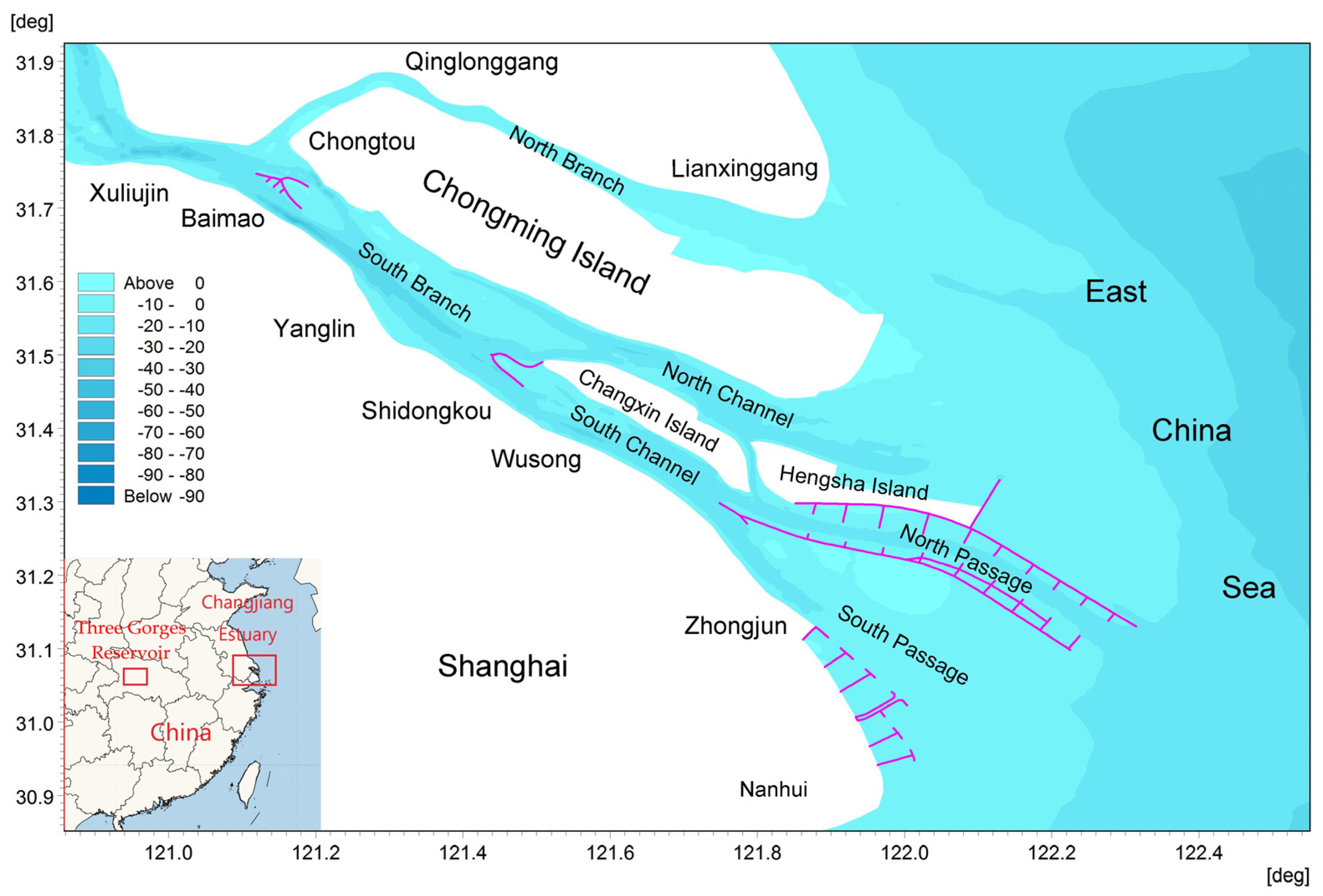
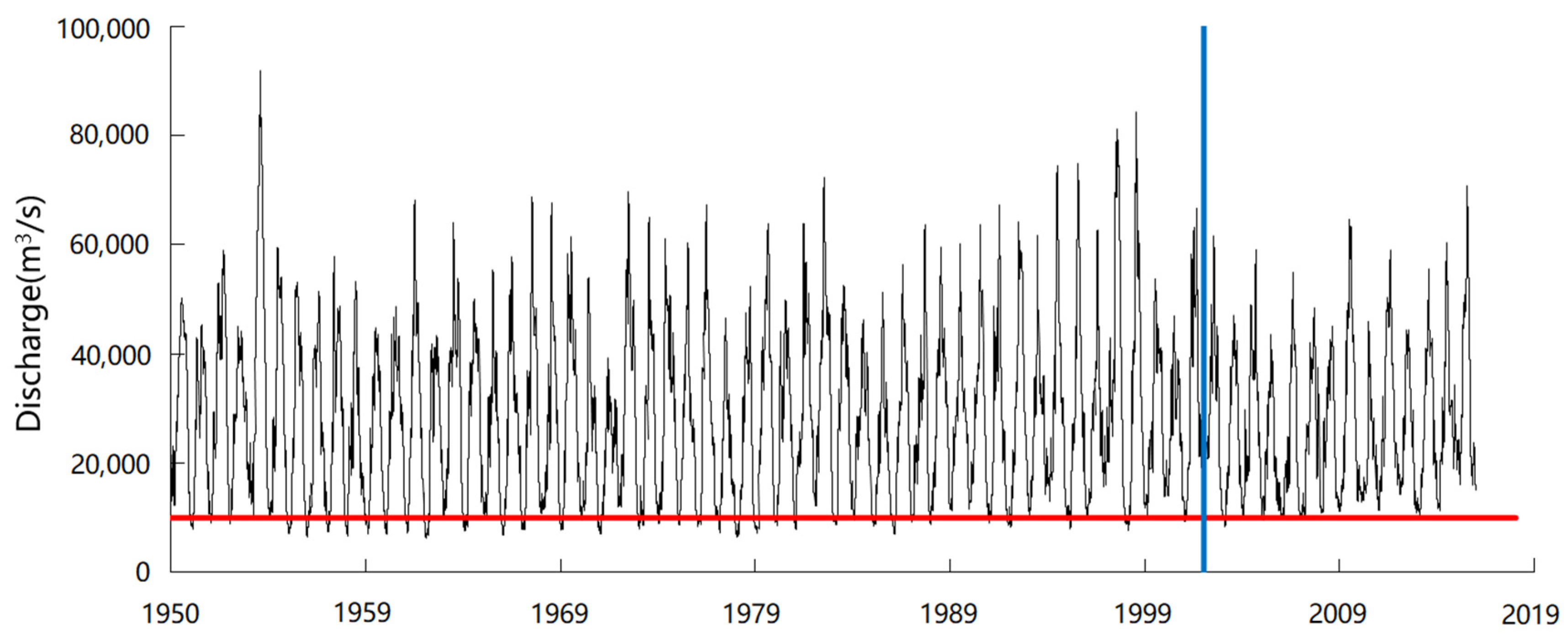

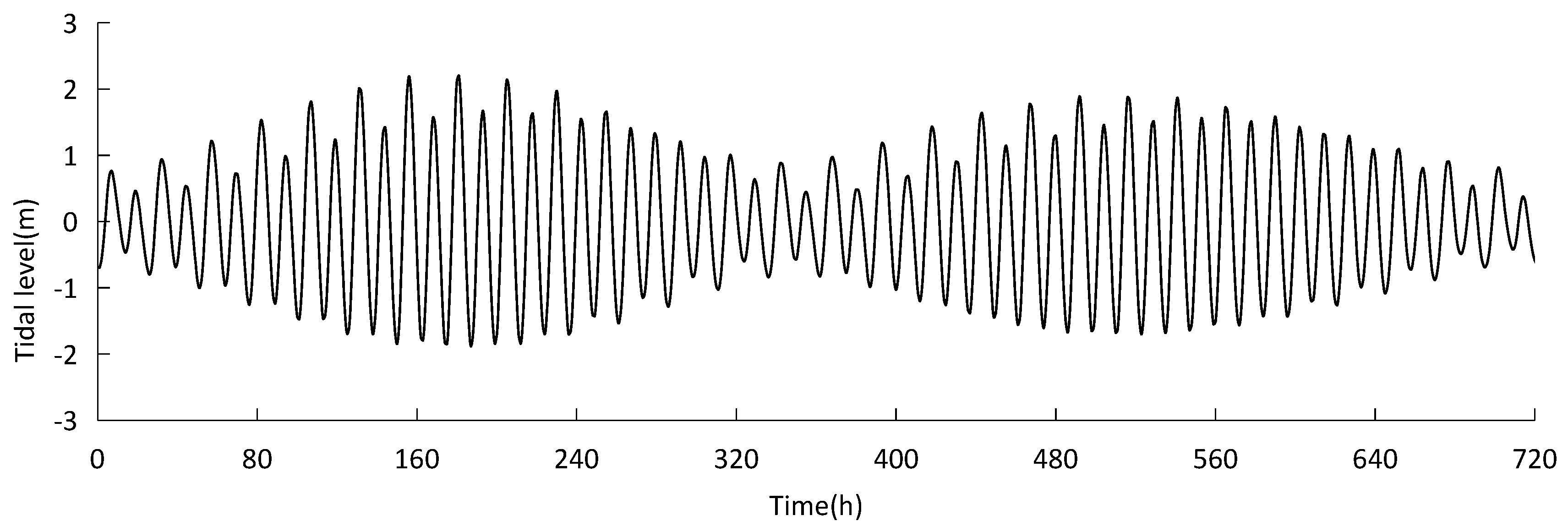
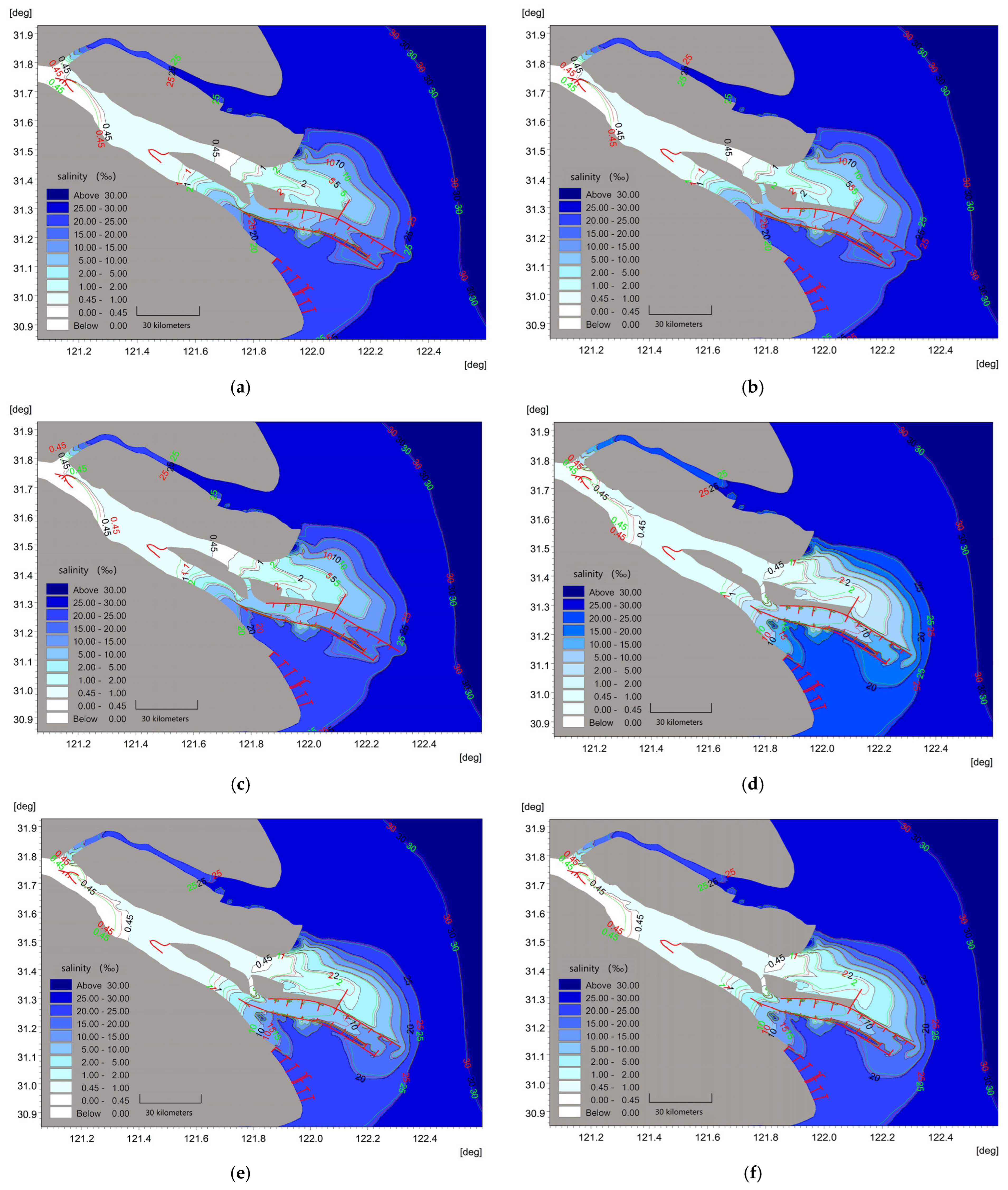
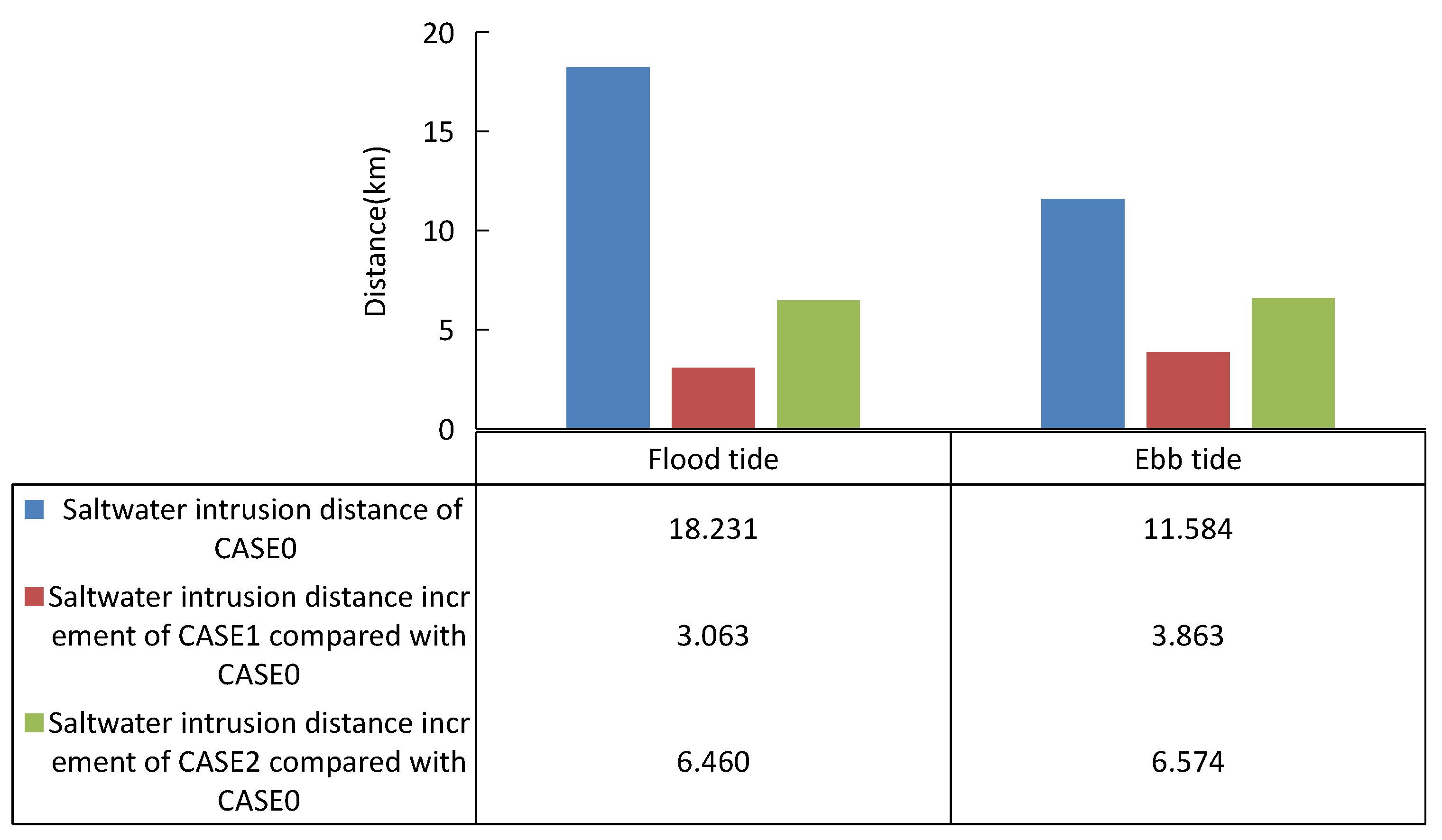
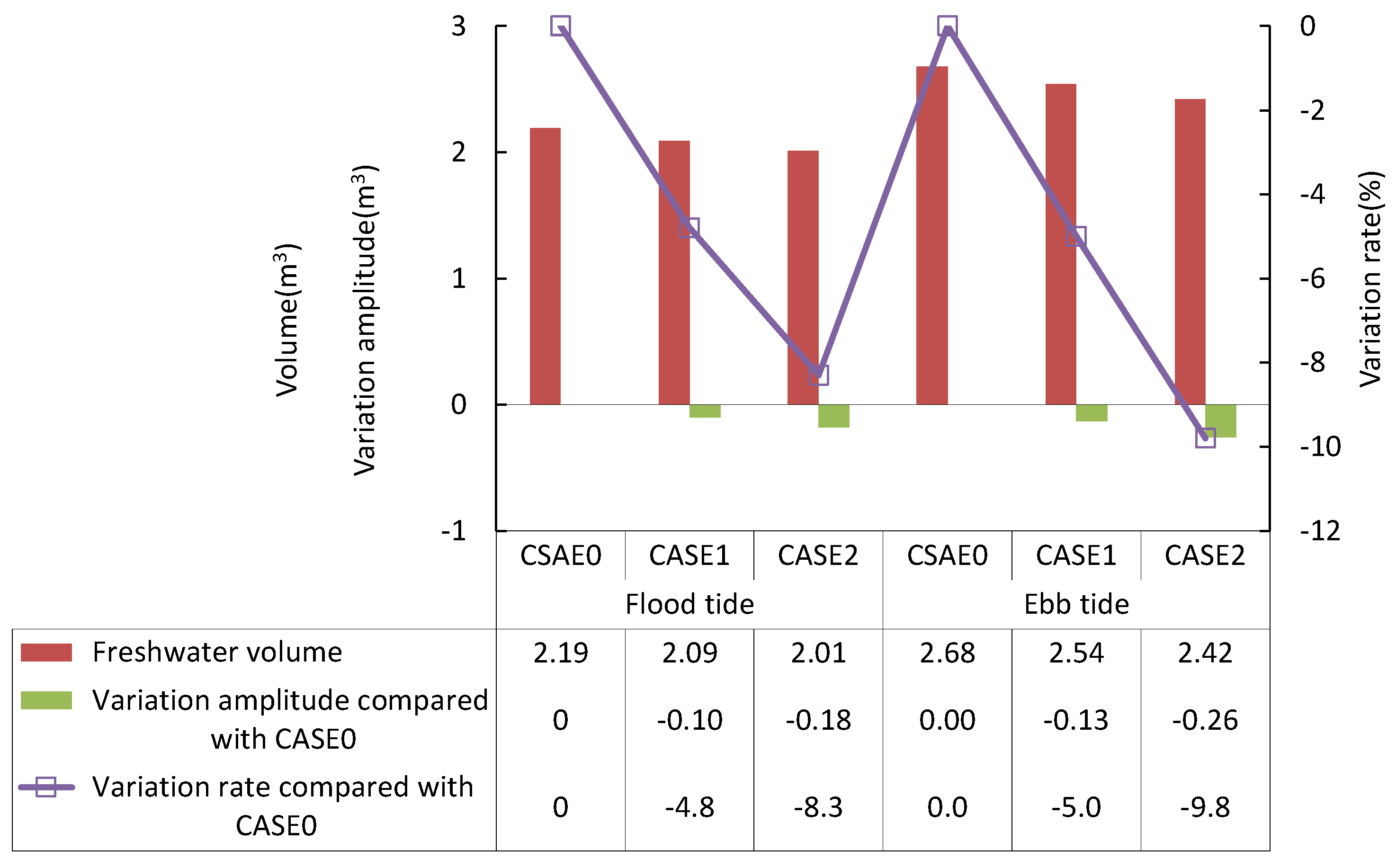
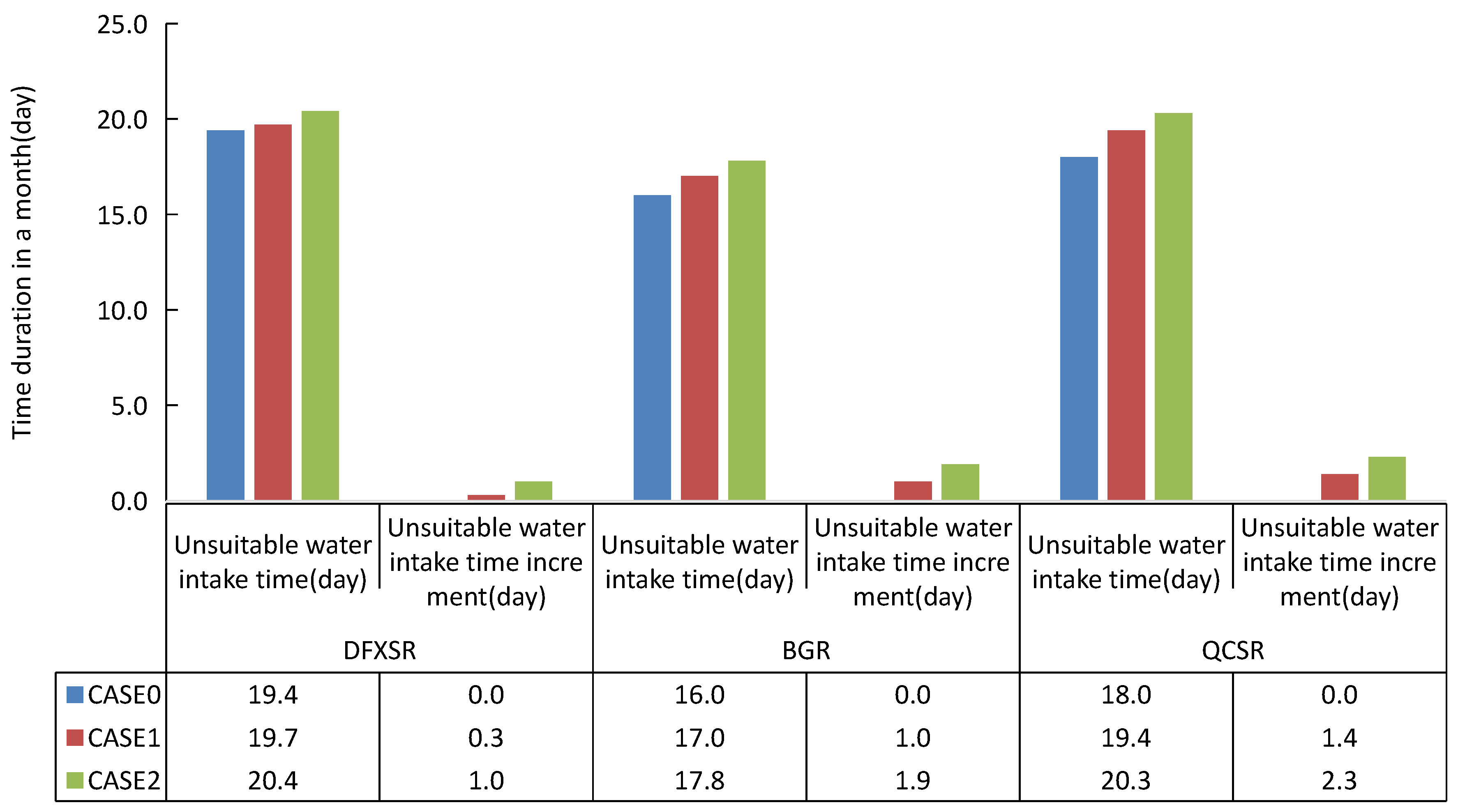

| Item | Coefficient | |||
|---|---|---|---|---|
| Factor | Water Layer | CC | SS | RMSE |
| Tide level (m) | / | 0.94 | 0.92 | 0.09 |
| Current speed (m/s) | Surface layer | 0.76 | 0.77 | 0.11 |
| Middle layer | 0.81 | 0.82 | 0.09 | |
| Bottom layer | 0.78 | 0.79 | 0.11 | |
| Current direction (°) | Surface layer | 0.80 | 0.78 | 15.2 |
| Middle layer | 0.87 | 0.83 | 11.3 | |
| Bottom layer | 0.83 | 0.82 | 12.4 | |
| Salinity (‰) | Surface layer | 0.76 | 0.69 | 0.11 |
| Middle layer | 0.72 | 0.71 | 0.11 | |
| Bottom layer | 0.78 | 0.75 | 0.12 | |
| Tidal-Dynamic Conditions | Runoff Conditions | Wind-Field Conditions | Water Abstraction Discharge of the East Route of the South-to-North Water Transfer Project (m3/s) | ||
|---|---|---|---|---|---|
| General tidal process with a cumulative frequency of 50% | Monthly average discharge with guaranteed rate of 98% | Multi-year monthly average wind field during January and February in the dry season | CASE0 | CASE1 | CASE2 |
| 0 | 500 (Phase I) | 1000 (Phase II) | |||
| Tidal Dynamic Conditions | Wind Field Conditions | Runoff Conditions | Water Abstraction Discharge in the East Route of the South-to-North Water Transfer Project (m3/s) | ||||||
|---|---|---|---|---|---|---|---|---|---|
| General tidal process with a cumulative frequency of 50% | Multi-year monthly average wind field during January and February in the dry season | Monthly average discharge with 98% guarantee rate | CASE0 | CASE1 | CASE2 | CASE3~CASE7 | CASE8 | CASE9 | CASE10 |
| 0 | 100 | 200 | 300~700 | 800 | 900 | 1000 | |||
| Tidal Dynamic Conditions | Wind Field Conditions | Water Abstraction in the East Route of the South-to-North Water Transfer Project (m3/s) | Runoff Conditions (m3/s) | |||
|---|---|---|---|---|---|---|
| General tidal process with a cumulative frequency of 50% | Multi-year monthly average wind field during January and February in the dry season | 0 | CASE11 | CASE12 | CASE13 | CASE14 |
| 6730 (Historical monthly minimum discharge during 1950~2016) | 8000 | 20,000 | 22,610 (Monthly average discharge from October to next June during 2003~2016) | |||
Disclaimer/Publisher’s Note: The statements, opinions and data contained in all publications are solely those of the individual author(s) and contributor(s) and not of MDPI and/or the editor(s). MDPI and/or the editor(s) disclaim responsibility for any injury to people or property resulting from any ideas, methods, instructions or products referred to in the content. |
© 2024 by the authors. Licensee MDPI, Basel, Switzerland. This article is an open access article distributed under the terms and conditions of the Creative Commons Attribution (CC BY) license (https://creativecommons.org/licenses/by/4.0/).
Share and Cite
Huang, H.; Wang, Y.; Wang, S.; Lan, Y.; Huang, X. Saltwater Intrusion in the Changjiang River Estuary in Response to the East Route of the South-to-North Water Transfer Project in the New Period after 2003. Sustainability 2024, 16, 683. https://doi.org/10.3390/su16020683
Huang H, Wang Y, Wang S, Lan Y, Huang X. Saltwater Intrusion in the Changjiang River Estuary in Response to the East Route of the South-to-North Water Transfer Project in the New Period after 2003. Sustainability. 2024; 16(2):683. https://doi.org/10.3390/su16020683
Chicago/Turabian StyleHuang, Huiming, Yan Wang, Sheng Wang, Yinyu Lan, and Xiantao Huang. 2024. "Saltwater Intrusion in the Changjiang River Estuary in Response to the East Route of the South-to-North Water Transfer Project in the New Period after 2003" Sustainability 16, no. 2: 683. https://doi.org/10.3390/su16020683
APA StyleHuang, H., Wang, Y., Wang, S., Lan, Y., & Huang, X. (2024). Saltwater Intrusion in the Changjiang River Estuary in Response to the East Route of the South-to-North Water Transfer Project in the New Period after 2003. Sustainability, 16(2), 683. https://doi.org/10.3390/su16020683







